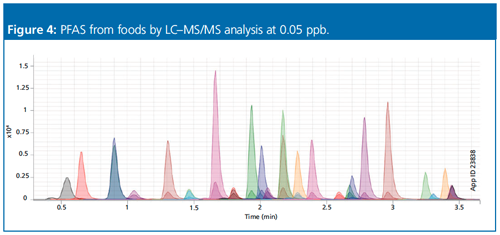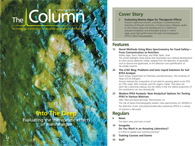Modern PFAS Analysis: New Analytical Options for Testing PFAS in Various Matrices
Per- and polyfuorinated alkyl substances (PFAS) are a rapidly growing environmental and human health concern. Owing to their broad commercial use, chemical stability, and bioaccumulation potential, these compounds are widely dispersed in the environment and can cause exposure through many potential pathways. To adequately estimate exposure risks, analytical methods are required that can measure low levels of PFAS compounds in many types of matrices. As will be described, recent advances in solid-phase extraction (SPE) and liquid chromatography tandem mass spectrometry (LC–MS/MS) have enabled the identification and quantification of a large number of PFAS compounds at low concentration (
Photo Credit: antishock/Shutterstock.com

Allen Misa and David Kennedy, Phenomenex, Inc., Torrance, California, USA
Per- and polyfuorinated alkyl substances (PFAS) are a rapidly growing environmental and human health concern. Owing to their broad commercial use, chemical stability, and bioaccumulation potential, these compounds are widely dispersed in the environment and can cause exposure through many potential pathways. To adequately estimate exposure risks, analytical methods are required that can measure low levels of PFAS compounds in many types of matrices. As will be described, recent advances in solid-phase extraction (SPE) and liquid chromatography tandem mass spectrometry (LC–MS/MS) have enabled the identification and quantification of a large number of PFAS compounds at low concentration (<1ng/g) in such diverse matrices as water, sediment, and dairy products.
What do people, polar bears, pizza boxes, and firefighting foams have in common? PBTs! Persistent bioâaccumulative toxins (PBTs) have long been an environmental and health concern. Over the years, regulatory agencies have established guidelines and limits to protect the environment and human health from exposure to these compounds. Welâknown examples include: chlorinated dibenzodioxins (and related dioxinâlike compounds), polynuclear aromatic hydrocarbons (PAHs), and polychlorinated biphenyls (PCBs).
More recently, however, per- and polyfuorinated alkyl substances (PFAS) have become the next wave of PBTs to hit the global environmental testing radar. These compounds have been widely used in commercial products as diverse as firefighting foams and pizza boxes. PFAS have been detected globally in the blood of mammals from cows to human beings and even in Arctic polar bears-very far removed from either aircraft fires or pizza boxes. As a result of these findings, in 2016 the U.S. EPA issued a drinking water health advisory level for PFAS at 70 parts per trillion. As more environmental monitoring data are collected, additional regulations are likely to follow (1,2).
What are PFAS and Why is there Concern?
PFAS are long-chain aliphatic substances with fluorine substitutions on multiple carbon atoms (3). Owing to their thermal and chemical stability and their unique combination of hydrophilic and hydrophobic properties, PFAS have been used extensively in such diverse products as firefighting foams, non-stick food packaging, stain-resistant upholstery, and waterproof fabrics. They are very chemically and thermally stable and are resistant to degradation in aqueous environments, leading to trace-level contamination throughout much of the global water supply. As a result of their widespread use, environmental stability, and bioaccumulative propensity, some of the longer-chained PFAS compounds, such as perflurooctanoic acids (PFOA) and perflourooctane sulfonic acids (PFOS) have found their way into the human biome. A 2007 report found trace levels of PFAS in over 98% of the thousands of human blood samples tested (4). And, although PFAS are not acutely toxic, human exposure to PFAS residues has been linked to adverse health effects, perhaps owing to the endocrineâdisrupting properties of these materials. As a result, analytical testing has greatly expanded beyond the initial focus on simple drinking water and
is now being performed on diverse matrices such as soil, wastewater, and food. This expansion has revealed several new analytical challenges.
The Challenge of PFAS in the Analytical Laboratory Setting
PFAS analytical testing procedures generally use high performance liquid chromatography (HPLC) or ultrahighâpressure LC (UHPLC) coupled with tandem mass spectrometry (MS) detection systems. As a result of the ubiquitous presence of PFAS in the environment, the contamination of laboratory blanks by trace levels of PFAS has become a great challenge. Potential PFAS interferences can arise from the analytical system components themselves, the laboratory water, or even “clean” analytical solvents. PFAS can be present in laboratory instruments and sample preparation and collection devices-particularly in plastic components-and can bleed into the flow path during analysis. Therefore, to ensure accurate results, the reduction of background PFAS contamination originating from both the preparation and LC systems must be a primary goal.
Techniques to Reduce PFAS Background in HPLC Analysis
A great deal of research has been done on background reduction. This has led to useful strategies for improved HPLC and UHPLC analysis for PFAS. Some simply remove or replace contaminated items from the workflow, others use specific products to separate system-generated PFAS from sampleârelated PFAS.
Some examples include:
Reduce system LC contamination:
- Replace conventional tubing and filters with material free from fluorinated polymers
- Use vial caps without PTFE septa
Use a delay HPLC column to separate system PFAS from sample PFAS:
- Connect the delay column after the pump and before the HPLC column injector
- A short (50 mm) column length is usually sufficient; increase to 100 mm for higher levels of system PFAS contamination
- The delay column should be as retentive (or more retentive) than the analytical column, but efficiency and selectivity are not critical
In addition to these analytical system modifications, it is often beneficial to optimize the method for specific sample matrices. The use of QuEChERS, onâline and offâline solidâphase extraction (SPE), and direct injection often helps to improve method sensitivity while reducing accumulated PFAS background during sample concentration steps. The following examples will illustrate the wide array of options available.
Sample Preparation and HPLC or UHPLC Methods for PFAS Analysis in Environmental Samples
Determination of PFAS in Sediments Using QuEChERS Extraction and LC–MS/MS: Owing to the early EPA focus on PFAS in drinking water, many methods have been presented on the extraction and analysis of PFAS in this very simple matrix. However, literature offers far fewer examples of PFAS analysis in more challenging matrices such as sediments and sludges. Recently, the Los Angeles County Sanitation District developed and validated a procedure for the analysis of PPCPs, pyrethoroids, and now PFAS from marine and freshwater sediments using QuEChERS extraction and LC–MS/MS analysis (Figure 1) (5,6). This application of QuEChERS for the environmental analysis of marine and fresh water sediments represents a novel use of this sample preparation technique, which was originally developed (and is now widely used) for the analysis of trace levels of pesticides in food products.
While QuEChERS as a sample preparation technique is widely used for the preparation of food samples in the analysis of pesticide residues, it is now beginning to be applied to traditional environmental samples. In Figure 1, QuEChERS was shown to be a fast, efficient, and costâeffective procedure for extracting 19 PFAS analytes and resulted in average recoveries within 80–120% with the RSD of all analytes falling below 10%. PFAS, once released into the aquatic environment, will partition between the water phase and sediment. Therefore, to understand the fate and transport of these compounds, it is essential to accurately measure both the solid and liquid environmental fractions. The use of QuEChERS sample preparation to remove matrix interferences allows these important distinctions to be made.

Quantitation of PFAS in Drinking Water Using Direct Injection by LC–MS/MS: As previously noted, the elimination of background contamination is a major challenge in PFAS analysis. Ironically, sample preparation and concentration steps such as liquid extraction and SPE are often the prime sources of such background contamination. Therefore, it would be desirable to devise analytical procedures that reduce or, ideally, eliminate sample preparation steps that involve contact with plastic components (7). In the case of a clean matrix such as drinking water, this goal is achievable through direct injection, provided that the LC–MS/MS instrumentation used is sufficiently sensitive to obviate the need for analyte preconcentration.
A direct injection method was developed by Test America in Sacramento, California, USA, for the quantitation of 17 PFAS analytes in water samples at the 1–10 ng/L level. The procedure featured the dilution of the analyte water sample in methanol and direct injection of 950 μL of the diluted sample into the LC–MS/MS system. However, to achieve such low quantitation levels, it was necessary to install a delay column to isolate PFAS contamination originating from the system pumps and eluents. A fully porous 5 µm 30 × 2.0 mm TMS-end-capped C18 HPLC column was installed outside of the column oven between the pump mixing chamber and the column for this purpose. A fully porous 3 µm 100 × 3.0 mm ethane-crosslinked C18 column was used for the analytical separation (Figure 2) (7). The application of a preliminary “delay column” ahead of the analytical column neatly circumvented the ubiquitous PFAS background interference arising from instrument and reagents that had plagued earlier PFAS methods (6).

Analysis of Perfluoronated Compounds (PFCs) including PFASs by On-line SPE and LC–MS/MS from Drinking Water: As mentioned above, off-line sample preparation techniques such as SPE can contribute to PFAS background contamination. However, on-line SPE has been shown to be an excellent way to avoid the off-line SPE contamination problem while still providing good analyte concentration and cleanup. Onâline SPE is just as sensitive as its off-line counterpart (owing to larger injection volume onto the LC column), but it eliminates exposure to components used in off-line SPE that contribute to PFAS background contamination. In addition, on-line SPE also significantly increases sample throughput and allows the collection of smaller sample volumes in the field. A method was developed and validated by Babcock Laboratories in Riverside, California, USA, using a weak ion exchange SPE column, sample preparation step, and a superficially porous, ethaneâcrosslinked C18 HPLC column. The weak anion exchange onâline SPE proved to be suitable for cleanup and concentration. It was also shown that the use of aqueous ammonia in the mobile phase, rather than the more commonly used ammonium acetate, provided a better MS-ionization environment for the 20 PFAS analytes. Furthermore, the use of a superficially porous, ethane crosslinked C18 column supported the higher pH contributed by the ammonia mobile phase, resulting in the overlaid chromatogram shown in Figure 3 (8).

What About Food?
Most environmental PFAS analyses discussed so far have been concerned with the traditional water, soil, and sediment phases that define pollutant disposal and transport. However, it is proven that pollutants that are discharged into the environment can potentially end up in the human and animal food supply. Owing to the widespread presence of PFAS in the environment and the high potential for bioaccumulation, this food safety concern is coming under much greater scrutiny. Even with the decreased use of PFAS in commercial products, this apprehension continues as a result of the exceptional persistence of PFAS in the environment.
Therefore, in addition to the increased frequency demand for PFAS analysis in traditional environmental samples, there is a growing interest in testing for lowâlevel PFAS contamination in food matrices intended for human consumption. Described below is a fast and sensitive LC–MS/MS method codeveloped by Weck Laboratories and Phenomenex to analyze PFAS residues at low ppb levels in diverse food samples (Figure 4). Highâfat matrices-milk, cheese, and fish-were intentionally chosen to challenge the method. Sample preparation is key to method performance; the traditional QuEChERS technique enabled 1 ng/g sensitivities, whereas an additional, optional SPE cleanup enabled 0.1 ng/g sensitivity and ensured optimum LC–MS/MS performance (9).

Conclusions
As a result of their unique chemical properties and widespread dispersion, PFAS are now recognized as a much greater environmental challenge than originally imagined. As more information is developed, the scope and magnitude of the problem continues to increase. Consider how the initial focus on contaminated water has been followed by the knowledge of widespread presence in human and animal blood and has only now led to the investigation of potential transmission to the food supply. On the positive side-if there is a positive side-analytical science has now evolved to the state where a combination of new sample preparation techniques and advanced LC–MS/MS technology is widely available and capable of meeting the investigatory challenge. This tool set was not available even as recently as a decade ago.
Further Information
Readers are invited to visit www.phenomenex.com/PFAS where a snapshot of some of the best current PFAS analytical techniques has been compiled. Readers may also want to consider the 2018 National Environmental Monitoring Conference to be held 6–10 August 2018 in New Orleans, Louisiana, USA. Sponsored by the US Environmental Protection Agency, this conference will feature a full-day session titled “Characterization of Polyfluoroalkyl Substances in the Environment”.
References
- PFAS in Artic Birds: https://stud.epsilon.slu.se/6902/11/axelson_s_140625.pdf
- PFAS in Polar bears: http://www.natureworldnews.com/articles/13479/20150316/pollution-giving-polar-bears-brain-damage.htm
- PFAS in 98% of blood samples: https://www.ncbi.nlm.nih.gov/pmc/articles/PMC2072821
- EPA 70 ppt Health Advisory: https://www.gpo.gov/fdsys/pkg/FR-2016-05-25/pdf/2016-12361.pdf
- NEMC 2018: http://www.nemc.us/meeting/2018/confinfo.php
- http://www.phenomenex.com/ViewDocument?id=determination+of+perfluoroalkyl+substances+(pfas)+in+sediments+by+quechers+and+lc-ms_ms+(tn-0117)
- https://www.phenomenex.com/ViewDocument?id=analysis+of+perfluorinated+compounds+(pfcs)+in+aqueous+matrices%2C+evaluating+various+online+spe+sorbents+by+lc-ms_ms+(tn-0116)
- https://az621941.vo.msecnd.net/documents/203693ce-3d2b-436b-abdd-3402d55f2b2b.pdf
- Pierri, Agustin., Weck Laboratories, City of Industries, CA, USA
Allen Misa is the Global Marketing Manager-Food and Environmental at Phenomenex. He holds an M.Sc. in healthcare administration from California State University, Long Beach, USA, along with a B.Sc. in microbiology and chemistry from California State Polytechnic University, Pomona, USA. He is responsible for developing technical tools and resources for the use of chromatography in the food and environmental industries.
David C. Kennedy is Business Development Manager for Phenomenex. He is a graduate of Iowa State University with a B.S. degree in chemistry and a Ph.D. degree in analytical chemistry. His professional career has spanned over 45 years with a focus on food safety and environmental monitoring. He has had sequential assignments in industrial R&D, contract testing laboratories, and in the manufacture of analytical instrument and consumables.
E-mail:allenm@phenomenex.com / Davidk@phenomenex.comWebsite:www.phenomenex.com

Characterizing Plant Polysaccharides Using Size-Exclusion Chromatography
April 4th 2025With green chemistry becoming more standardized, Leena Pitkänen of Aalto University analyzed how useful size-exclusion chromatography (SEC) and asymmetric flow field-flow fractionation (AF4) could be in characterizing plant polysaccharides.














